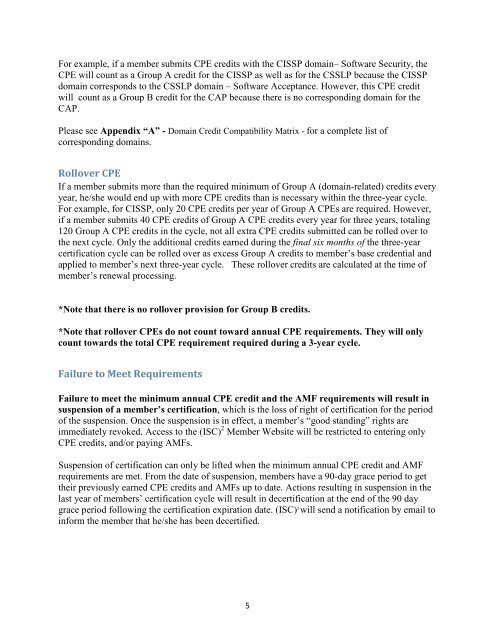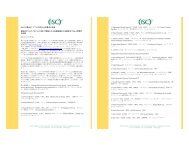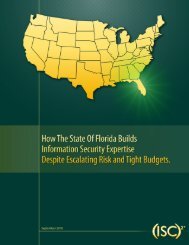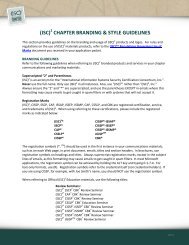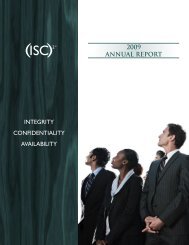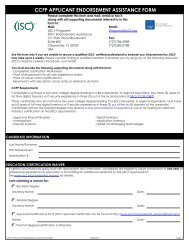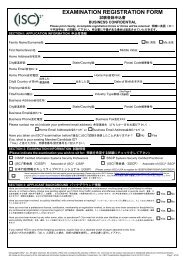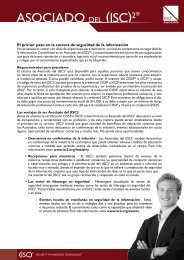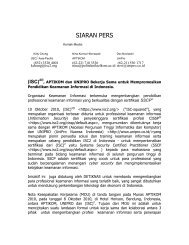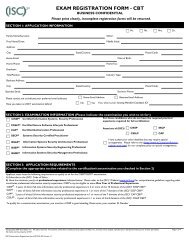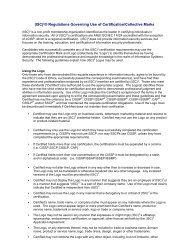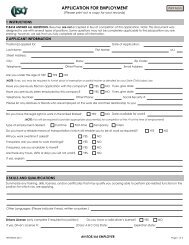CPE Policies and Guidelines - ISC
CPE Policies and Guidelines - ISC
CPE Policies and Guidelines - ISC
Create successful ePaper yourself
Turn your PDF publications into a flip-book with our unique Google optimized e-Paper software.
For example, if a member submits <strong>CPE</strong> credits with the CISSP domain– Software Security, the<br />
<strong>CPE</strong> will count as a Group A credit for the CISSP as well as for the CSSLP because the CISSP<br />
domain corresponds to the CSSLP domain – Software Acceptance. However, this <strong>CPE</strong> credit<br />
will count as a Group B credit for the CAP because there is no corresponding domain for the<br />
CAP.<br />
Please see Appendix “A” - Domain Credit Compatibility Matrix - for a complete list of<br />
corresponding domains.<br />
Rollover <strong>CPE</strong><br />
If a member submits more than the required minimum of Group A (domain-related) credits every<br />
year, he/she would end up with more <strong>CPE</strong> credits than is necessary within the three-year cycle.<br />
For example, for CISSP, only 20 <strong>CPE</strong> credits per year of Group A <strong>CPE</strong>s are required. However,<br />
if a member submits 40 <strong>CPE</strong> credits of Group A <strong>CPE</strong> credits every year for three years, totaling<br />
120 Group A <strong>CPE</strong> credits in the cycle, not all extra <strong>CPE</strong> credits submitted can be rolled over to<br />
the next cycle. Only the additional credits earned during the final six months of the three-year<br />
certification cycle can be rolled over as excess Group A credits to member’s base credential <strong>and</strong><br />
applied to member’s next three-year cycle. These rollover credits are calculated at the time of<br />
member’s renewal processing.<br />
*Note that there is no rollover provision for Group B credits.<br />
*Note that rollover <strong>CPE</strong>s do not count toward annual <strong>CPE</strong> requirements. They will only<br />
count towards the total <strong>CPE</strong> requirement required during a 3-year cycle.<br />
Failure to Meet Requirements<br />
Failure to meet the minimum annual <strong>CPE</strong> credit <strong>and</strong> the AMF requirements will result in<br />
suspension of a member’s certification, which is the loss of right of certification for the period<br />
of the suspension. Once the suspension is in effect, a member’s “good st<strong>and</strong>ing” rights are<br />
immediately revoked. Access to the (<strong>ISC</strong>) 2 Member Website will be restricted to entering only<br />
<strong>CPE</strong> credits, <strong>and</strong>/or paying AMFs.<br />
Suspension of certification can only be lifted when the minimum annual <strong>CPE</strong> credit <strong>and</strong> AMF<br />
requirements are met. From the date of suspension, members have a 90-day grace period to get<br />
their previously earned <strong>CPE</strong> credits <strong>and</strong> AMFs up to date. Actions resulting in suspension in the<br />
last year of members’ certification cycle will result in decertification at the end of the 90 day<br />
grace period following the certification expiration date. (<strong>ISC</strong>) 2 will send a notification by email to<br />
inform the member that he/she has been decertified.<br />
5


